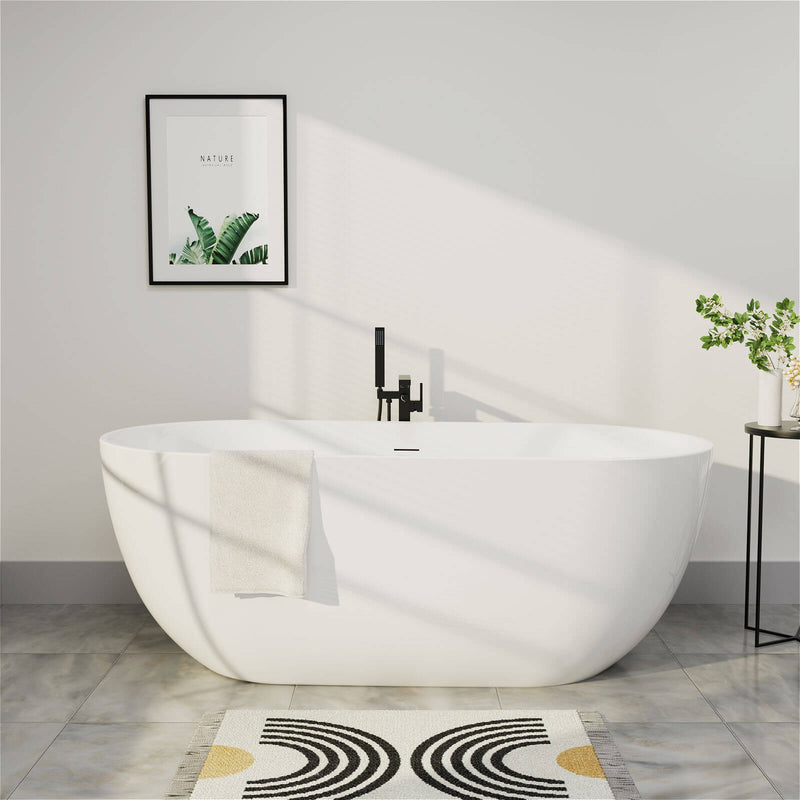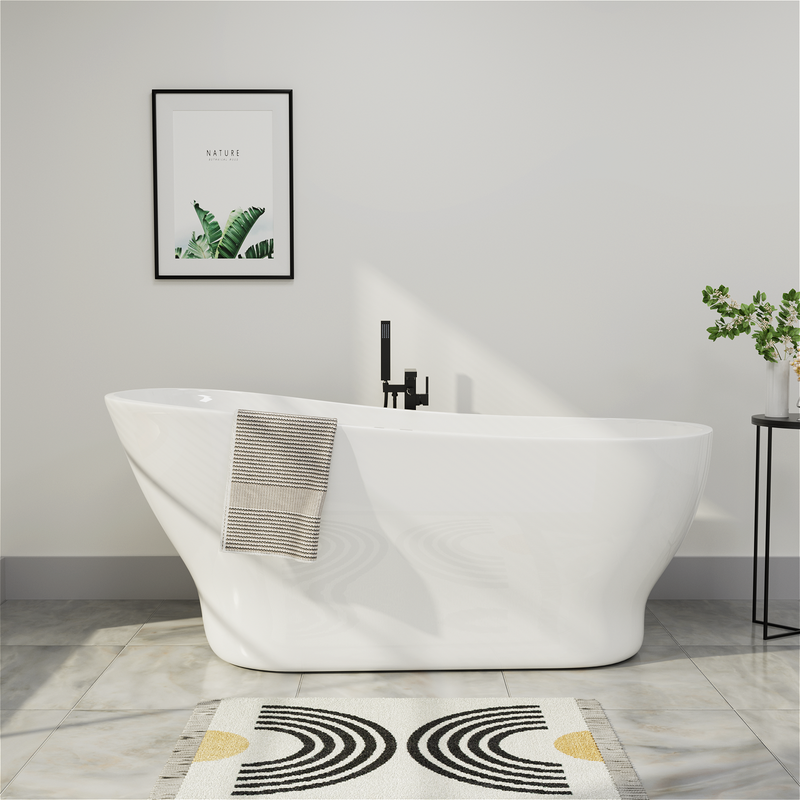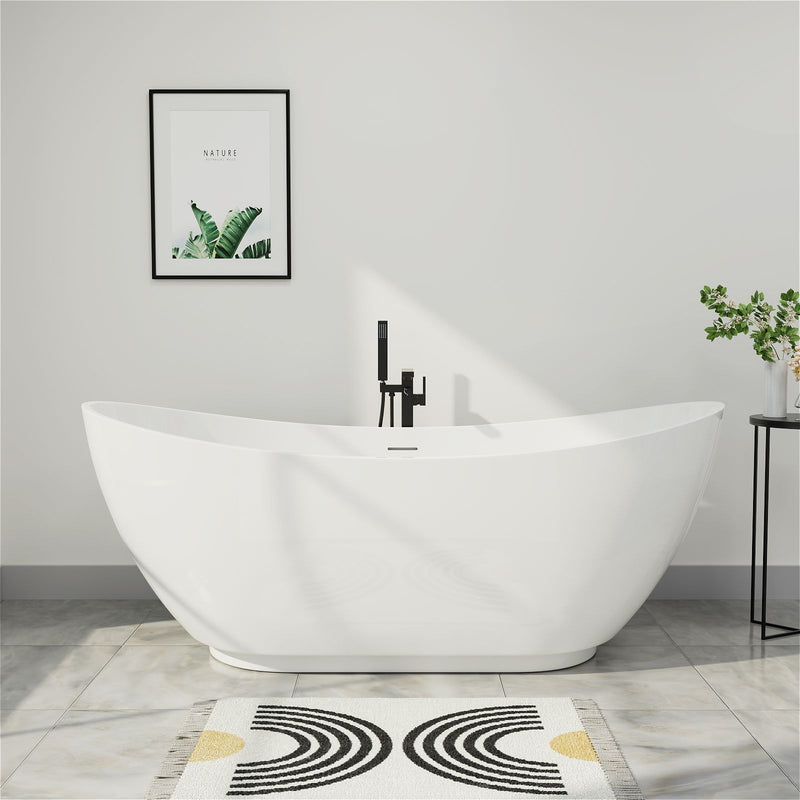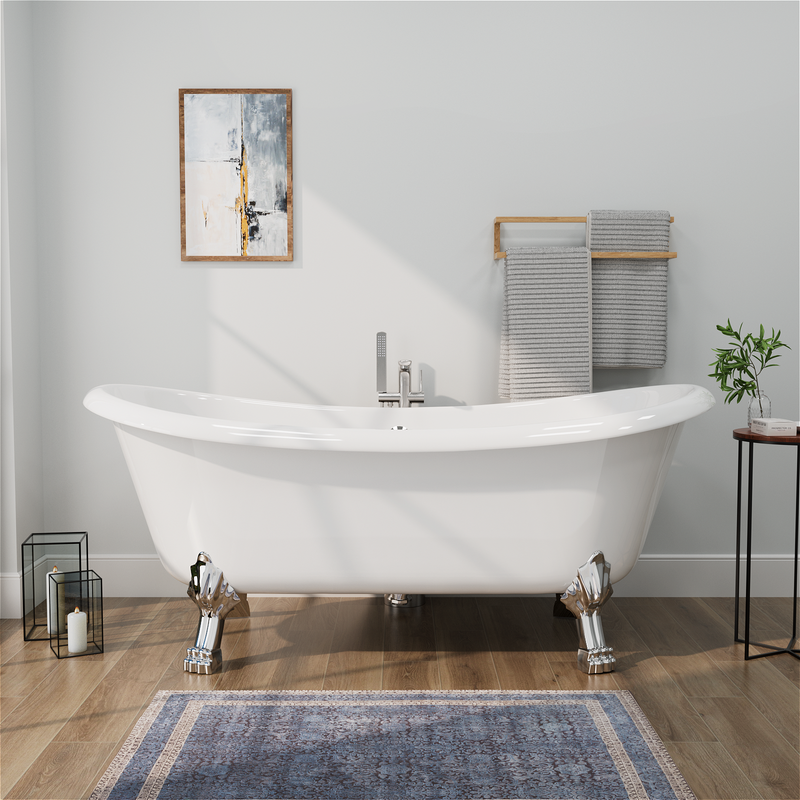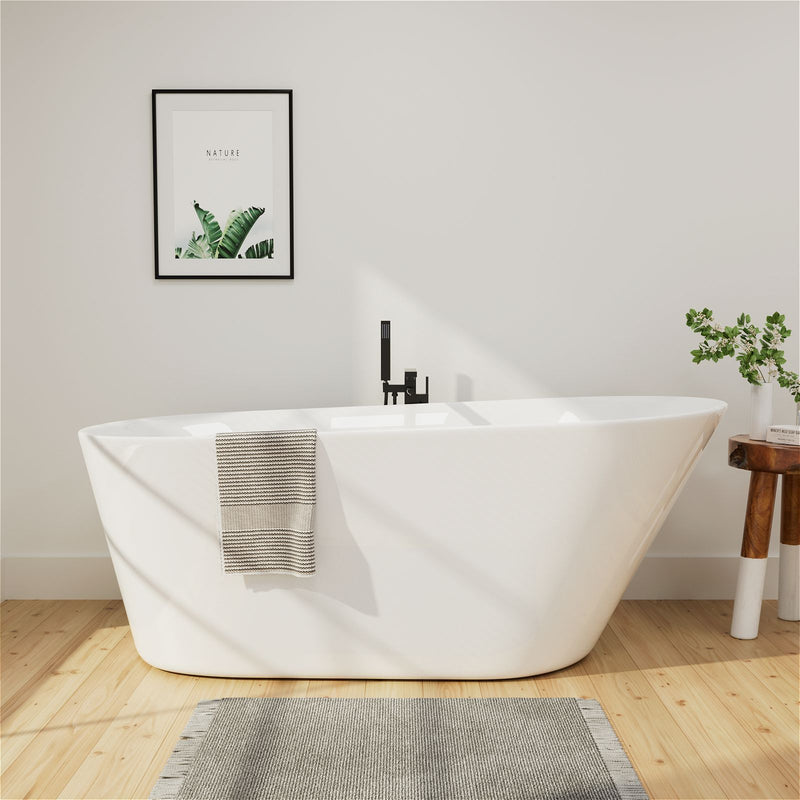A freestanding tub faucet is more than just a household fixture. It is a vital component that adds character, function, and style to your bathroom. Designed for freestanding bathtubs, this unique faucet can be placed on its own, without being attached to a wall or tub for water supply. As classic and modern trends have evolved, so have the style and practicality of freestanding bathtub faucets, resulting in a wide variety of designs and styles to suit your personal preferences and ideal bathroom ambiance.
Components of a Freestanding Bathtub Faucet
A standard freestanding bathtub faucet consists of several components.
Base or Floor Mount: The support that contacts the floor, holds the entire faucet in place and directs the water from the source.
Faucet Body: This part contains the valve that controls the water flow.
Spout: This is the outlet where the water flows into the bathtub.
Hand Shower or Shower Wand: Optional and removable, used to focus the water flow.
How to Install a Freestanding Bathtub Faucet?
Here are some tips to help you install a freestanding bathtub faucet.
First, you must ensure that you can control the temperature and other controls of the bathtub. Place the sensor near the faucet.
Position the faucet at least 5 inches from the edge of the tub to avoid unwanted splashing.
Choose the right faucet spout for your tub size. Measure from the bottom of the faucet body to the middle of the spout.
Position the faucet at the lower end of the tub to make it easy for you to access the tub.
Benefits of Freestanding Tub Faucets
Stylish Design
Modern Appeal
The design of freestanding tub faucets is one of their biggest selling points. They have a sleek, modern look that can transform an ordinary bathroom into a stylish spa space. The minimalist frame and visible piping create an attractive aesthetic that fits into almost any interior design style, from contemporary to traditional.
Variety of Styles
With a wide variety of styles and finishes, there's always a freestanding tub faucet that fits your taste and pairs well with other bathroom fixtures. From chrome and brass to bronze and nickel, the wide range of faucets makes it easy to customize the look and feel of your tub area.
Features
Easy Access
Freestanding tub faucets are typically mounted directly on the tub or on the floor next to it. This installation style allows you to easily adjust the water pressure and temperature without having to reach over the edge of the tub.
Extra features
Some freestanding faucets offer extra features, such as hand showers, thermostats, and flow modes, making them a versatile and convenient choice for your bath. These additional features can make your bathing experience more comfortable and enjoyable.
Installation flexibility
Unlike recessed bath faucets, freestanding bath faucets can be installed anywhere in the bathtub. You have the freedom to choose exactly where to install the faucet, giving you more flexibility in the installation and design of your bathroom.
Disadvantages of Freestanding Bathtub Faucets
Installation Challenges
Need Professional Help
Installing a freestanding bath faucet requires some skill and can be difficult for DIY enthusiasts. Incorrect installation can cause plumbing problems, so it is usually recommended to seek professional help.
Requires Additional Space
Freestanding bath faucets require a certain amount of space to install. If your bathroom already has a small space, installing a freestanding faucet can be difficult. If not planned properly, the bathroom may appear crowded.
Cost
Priced
Freestanding bathtub faucets can be more expensive than other types of faucets due to their extravagant design and complex installation. The costs can add up, especially when you add in the cost of professional installation.
Higher Maintenance Costs
The minimalist design of a freestanding bathtub faucet may require more maintenance over time than a countertop or wall-mounted faucet. Since the pipes are usually exposed and more susceptible to damage, they may also need to be cleaned more frequently, increasing your overall maintenance costs.
Limited Options
Freestanding bathtub faucets may not be practical if your bathtub is against a wall or in a corner. They are best suited for freestanding bathtubs with plenty of space around them, which some bathrooms can't accommodate. Consider your bathroom layout and bathtub location before deciding to install a freestanding faucet.
Water Pressure
A freestanding bathtub faucet may mean lower water pressure. This is because these types of faucets are usually taller than other types of faucets and require more water to achieve the same water pressure. Therefore, if the water pressure in your home is already low, a freestanding bathtub faucet may not be the best choice.
Accessories You Can Add to Faucets
When we think of accessories that can be added to a faucet, the first thing that comes to mind is a handheld showerhead. Almost all faucets come with a hand shower mount. You can easily connect the hand shower with a 4-inch or 5-inch connecting hose. Most faucets come with a hand shower holder called a "holder". A hand shower is a great alternative to an overhead shower. The main reason is that it is easy to operate. In addition, with a hand shower, you can easily clean places in the bathtub that you can't reach normally. If you have pets at home, a hand shower will be a great addition to the bathtub.
Next, it is best to add a thermostat to the faucet. Who doesn't want to maintain the most comfortable temperature while bathing and enjoy an unprecedented refreshing experience? But at the same time, you must also make sure that you don't need to adjust the water temperature frequently when bathing.
This is where the thermostatic control sensor comes in handy. The thermostatic mixing valve is like the "HVAC system (HVAC)" of the bathtub. Its function is simple. Instead of manually mixing hot and cold water, the thermostatic mixing valve automatically mixes hot and cold water and maintains a constant temperature throughout the bathing process. When installing a thermostatic sensor, you should follow the regulations of your state. Please check your local building and plumbing codes to ensure that the relevant requirements are met.
Precautions for Using freestanding Bathtub Faucets
Proper Installation
The first step to ensuring that your freestanding bathtub faucet works properly for a long time is to install it correctly. It is highly recommended to hire a professional plumber for installation. An experienced plumber will ensure that the faucet is securely mounted to the floor or patio and that the joints are waterproof. This initial step can prevent leaks and other problems in the future.
Regular Maintenance
Maintaining your freestanding bathtub faucet is essential. Check regularly for any loose parts or connections. Tighten any loose screws, bolts, or connections to prevent leaks or other damage. If you are not comfortable with self-maintenance, consult a professional plumber.
Water Pressure Control
The right water pressure is essential for the smooth operation of a freestanding bathtub faucet. Excessive water pressure can damage the faucet and its components, possibly causing leaks. To avoid this, consider installing a water pressure regulator if the water pressure is too high. This simple device can protect your faucet and other plumbing fixtures.
Temperature Balance
Maintaining a proper balance of hot and cold water is essential for your comfort and the life of your freestanding bathtub faucet. Sudden changes in temperature can put stress on the faucet valve core and other internal components. Use the handle gently to adjust the water temperature and avoid wild temperature swings.
Cleaning and Maintenance
Regular cleaning will not only keep your freestanding tub faucet looking like new, but it will also prevent mineral deposits and dirt buildup that can affect its performance. Use a mild detergent and a soft cloth to clean the faucet and handle. After cleaning, always rinse and dry the faucet thoroughly to prevent water spots or mineral deposits.
Use Soft Water
If you live in an area with hard water, consider installing a water softener. Hard water can cause minerals to build up on faucets, making them less efficient and even causing leaks. Softened water will be gentler on your plumbing.
Be Gentle
Handle your freestanding tub faucet carefully. Avoid applying excessive force when turning the handle on and off. Being gentle will not only extend the life of the faucet, but will also prevent excessive strain on the internal components.
Fix Leaks Promptly
If you notice any signs of a leak, such as a dripping faucet or standing water, take care of it right away. Putting off repairs can lead to greater damage and costly repairs. Contact a plumber as soon as possible to assess and fix any leaks.
Freestanding Tub Faucet Repair Solutions
Leaking Faucets
Leaking faucets are a common problem with freestanding tub faucets and are usually caused by things like worn gaskets, loose parts, or faulty seals. To repair a leaking faucet, follow these steps:
- Turn off the water supply to the faucet.
- Remove the handle and trim to access the cartridge or valve.
- Inspect the cartridge or valve for damage or wear.
- Replace any worn parts and reassemble the faucet.
- Turn the water supply back on and check for leaks.
If the faucet is still leaking after following these steps, you may need to replace the entire faucet. This will ensure that your freestanding tub faucet is functioning properly and prevent further water waste.
Low Water Pressure
Low water pressure is another common problem with freestanding tub faucets and is usually caused by sediment or debris that has accumulated in the faucet aerator. To restore water pressure, follow these steps:
- Remove the aerator from the faucet spout.
- Clean the aerator by soaking it in vinegar or using a small brush to remove any debris.
- Reinstall the aerator onto the faucet spout.
- Turn on the water and check to see if the water pressure has improved.
If cleaning the aerator does not improve the water pressure, consider replacing it with a new one to ensure optimal water flow in your freestanding tub.
Things to Know Before Buying a Freestanding Tub Faucet
Plumbing Compatibility
Before you start looking for a freestanding tub faucet, it is important to assess the plumbing compatibility of your bathroom. Freestanding tub faucets are usually floor-mounted, so you need to make sure your bathroom's plumbing system allows for this type of installation. You can consult a professional plumber to determine if your plumbing system can accommodate a freestanding faucet or if any modifications will be required.
Design and Style
Freestanding tub faucets come in a variety of designs and styles to suit different bathroom aesthetics. Whether you prefer modern minimalist style or classic retro style, there is a faucet that will suit you. Consider the overall design theme of your bathroom and choose a faucet that will fit perfectly with it. Pay attention to details such as the faucet's shape, finish, and handles to ensure it fits your aesthetic.
Height and Reach
Another key factor to consider is the height and reach of a freestanding bath faucet. The height should be appropriate for your bath for ease of use and comfort. Reach, or how far the spout extends into the bath, is crucial to preventing splashes and ensuring adequate water coverage. Measure the dimensions of your bath and compare them to the specifications of the faucet to ensure the right size.
Construction and Durability
Investing in a high-quality freestanding bath faucet is essential to ensure its longevity and performance. Choose a faucet made of durable materials, such as solid brass or stainless steel, as they offer excellent resistance to corrosion and abrasion. Also consider the faucet's finish, which should be corrosion and scratch-resistant. Choosing a well-made faucet will bring a reliable and durable experience to your bathroom.
Functions and Features
Beyond the basic water delivery function, a freestanding bath faucet can offer other features to enhance your bathing experience. Some faucets come with a hand shower for easy rinsing or filling. Some faucets may come with a thermostatic controller for precise temperature adjustment or a scald protection feature for added safety. Evaluate your needs and preferences, determine which features are important to you, and choose the right faucet accordingly.
Budget Considerations
As with any home improvement project, it is crucial to set a budget. Freestanding tub faucets vary widely in price, depending on their design, materials, and features. Before you begin your search, determine your budget and focus on finding a faucet that falls within your price range. Remember, while it is important to stay within your budget, sacrificing quality may result in a less satisfying experience in the long run.
Frequently Asked Questions About Freestanding Tub Faucets
What Should You Consider When Buying a Freestanding Faucet?
There are different things to consider when buying a freestanding faucet, including:
- Faucet Material
- Style/Features
- Color
- Faucet Finish
- Size
How High Should a Freestanding Faucet Be?
It is recommended that the faucet height should be 3 inches to 6 inches above the rim of the tub to avoid unwanted splashing. The higher the spout height, the more likely it is that water will splash. Therefore, if you are buying a freestanding faucet to go with a freestanding tub, you should first consider the height of the tub and then compare it to the height of the faucet before purchasing.
Where should I place my freestanding faucet?
The positioning of your freestanding faucet is up to you, however, just make sure you install it with enough space for cleaning and easy access to the filler base between the tub rim and the wall.
Do all freestanding tub faucets come with a hand shower?
Not all freestanding tub faucets come with a hand shower. However, many modern designs incorporate a hand shower because it is convenient and versatile. It is best to check the product details to make sure it includes all the tub faucet features you need.
How do I care for my freestanding tub faucet?
To care for your freestanding tub faucet, regular cleaning is essential. Using a mild soap solution and a soft cloth can remove surface dirt and prevent grime buildup. Never use harsh or abrasive cleaners as they may damage the surface. If hard water stains or mineral deposits are present, you may need to use a specialized cleaner.
How do I replace a freestanding tub faucet?
Replacing a freestanding tub faucet requires removing the old faucet and installing a new one. This can be a complex process that requires specific plumbing skills. Typically, it requires shutting off the water supply, disassembling the plumbing, removing the old faucet, and installing and connecting the new faucet.
Where can I buy a freestanding tub faucet?
There are many different places to buy freestanding tub faucets. Home improvement stores, kitchen and bath showrooms, and online retailers all offer a wide variety of options. Styles, quality, and prices vary widely, so be sure to do your homework to find the faucet that best suits your needs.
Can a freestanding tub faucet be used with any tub?
Most freestanding tub faucets are compatible with freestanding tubs. However, compatibility depends on the style, size, and design of the tub, as well as the plumbing system of the bathroom. When choosing a faucet, be sure to check the product specifications to ensure that it is compatible with your specific tub.
Are freestanding tub faucets expensive?
The price of freestanding tub faucets varies, depending on the style, brand, and material. Some basic models are affordable, but high-end designer faucets can cost a lot. As with any home improvement investment, it's important to strike a balance between cost, quality, and value.
What materials are best for freestanding tub faucets?
Freestanding bathtub faucets are often made of brass, a durable material. Some faucets may also come in finishes such as chrome, brushed nickel, bronze, or even gold. The choice of material will largely depend on personal preference as well as the style and decor of your bathroom.

